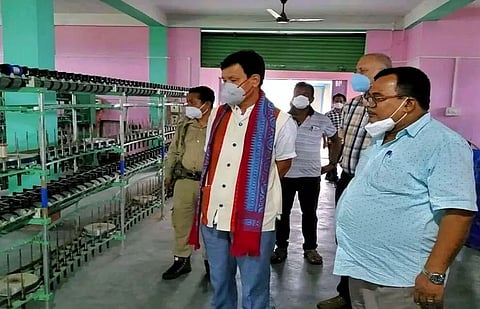
- Home
- Live Blog
- Breaking News
- Top Headlines
- Cities
- NE News
- Sentinel Media
- Sports
- Education
- Jobs

A CORRESPONDENT
TANGLA: State Handloom and Textile and Soil Conservation Minister Urkhao Gwra Brahma on Tuesday visited the Udalguri Sericulture Office complex.
During his visit, he inspected various projects in the vicinity of the office of the Sericulture department and also visited the eri and mulberry farm, the eri-cocoon bank, as well as the units where the muga silkworms are reared, silk is woven, reeled and spun. He also reviewed the implementation status of the projects. Officials of Udalguri district administration and also the Sericulture department of BTR (Bodoland Territorial Region), were also present during his visit.
Pertinently, Udalguri has an excellent track record as a model district in the entire BTR region, not only in eri and muga but also in mulberry silk production. The Bodoland Territorial Region (BTR) region -- covering Kokrajhar, Chirang, Baksa and Udalguri -- enjoys the unique distinction of producing all three varieties of commercially exploited natural silks - eri, muga and mulberry.
The Bodo belt is the largest producer of eri silk in Assam after Karbi Anglong. A total area of 2,895 hectares is covered under muga, eri and mulberry silkworm food plant in BTR (Bodoland Territorial Region) with nearly 51,195 families directly involved in the business of sericulture.
Five types of silkworms
There are five major types of silk of commercial importance, obtained from different species of silkworms which in turn feed on several food plants. Except mulberry, the other varieties of silks are generally termed 'non-mulberry silk'.
India has the unique distinction of producing all these commercial varieties of silk.
Mulberry: The bulk of commercial silk produced in the world comes from this variety and often silk generally refers to mulberry silk. Mulberry silk comes from the silkworm, Bombyx mori L. which solely feeds on the leaves of the mulberry plant. These silkworms are completely domesticated and reared indoors.
The major mulberry silk-producing States are Karnataka, Andhra Pradesh, West Bengal, and Tamil Nadu besides Jammu & Kashmir which together accounts for 92 % of the country's total mulberry raw silk production
Tasar: Tussah or Tasar is copperish colour, coarse silk mainly used for furnishings and interiors. It is less lustrous than mulberry silk, but has its own appeal. Tasar silk is generated by the silkworm, Antheraea mylitta which mainly thrive on the food plants Asan and Arjun. The rearings are conducted in nature on the trees in the open. In India, 'Tasar silk' is mainly produced in the States of Jharkhand, Chattisgarh and Orissa, besides Maharashtra, West Bengal and Andhra Pradesh. Tasar culture is the main stay for many a tribal community in India.
Oak Tasar:
It is a finer variety of tasar generated by the silkworm, Antheraea proyeli J. in India which feed on natural food plants of oak, found in abundance in the sub-Himalayan belt of India covering the states of Manipur, Himachal Pradesh, Uttar Pradesh, Assam, Meghalaya and Jammu & Kashmir. China is the major producer of oak tasar in the world and this comes from another silkworm which is known as Antheraea pernyi.
Eri: Also known as Endi or Errandi, Eri is a multivoltine silk spun from open-ended cocoons, unlike other varieties of silk.
Eri silk is the product of the domesticated silkworm, Philosamia ricini that feeds mainly on castor leaves. Ericulture is a household activity practised mainly for the protein -rich pupae, a delicacy for the tribal. Resultantly, the eri cocoons are open-mouthed and are spun. The silk is used indigenously for preparation of chaddars (wraps) for own use by these tribals. In India, this culture is practiced mainly in the north-eastern states and Assam. It is also found in Bihar, West Bengal and Orissa
Muga: This golden yellow colour silk is prerogative of India and the pride of Assam state. It is obtained from the semi-domesticated multivoltine silkworm known as Antheraea assamensis. These silkworms feed on the aromatic leaves of Som and Soalu plants and are reared on trees similar to that of 'tasar'. Muga culture is specific to the state of Assam and an integral part of the tradition and culture of that State. The muga silk -- a high-value product is used to produce popular products like the traditional Assamese three-piece wonder known as 'mekhela sador' and saris to mention a few.